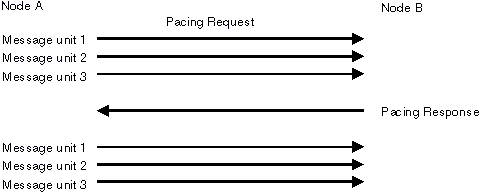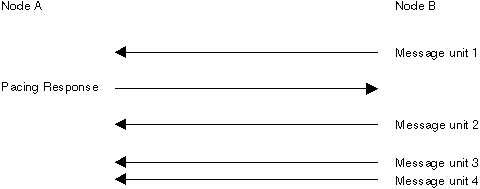 z/OS Communications Server: SNA Network Implementation Guide
z/OS Communications Server: SNA Network Implementation Guide
 z/OS Communications Server: SNA Network Implementation Guide
z/OS Communications Server: SNA Network Implementation Guide
|
Previous topic |
Next topic |
Contents |
Contact z/OS |
Library |
PDF
Pacing window z/OS Communications Server: SNA Network Implementation Guide SC27-3672-01 |
|
|
For example, in Figure 1 the pacing window size is three. When Node A sends three message units, it must wait for a pacing response (from Node B) before sending another message unit. The pacing response restores the pacing window size. Figure 1. Pacing flow – outbound pacing
 Figure 1 shows pacing from the sender's outbound pacing perspective. There could also be a pacing window size associated with the sender's receiving message units (inbound pacing). The pacing window size can be different from the outbound pacing window size. In Figure 2, Node A inbound pacing window size is two. Node B, after sending two message units, will not send additional message units until Node A sends a pacing response to Node B as shown in Figure 2. Figure 2. Pacing flow – inbound pacing
 A pacing window response can be sent before the pacing window size is reached. If the receiver sends the pacing response early (before having received the maximum number of requests), the sender transmits the first group of requests and can then send another group of requests. Figure 3 shows the flow when a pacing response is sent before reaching the pacing window size. Node A inbound pacing window size is three. Node A could send the pacing response after receiving message unit 1. Node B could send up to three more message units before another pacing response is required to be sent by Node A. Figure 3. Pacing flow – receiving early
pacing response
 


|
 Copyright IBM Corporation 1990, 2014 Copyright IBM Corporation 1990, 2014 |